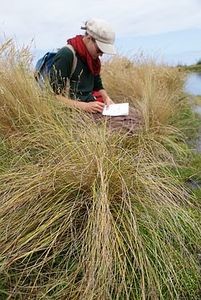 Counting Carex litorosa plants in Awarua Bay, Southland. Photo: Anne HumburgThe number of individual plants in some plant populations can be completely counted and a count in any one year can provide useful information about the changing state of a species population.
Counting Carex litorosa plants in Awarua Bay, Southland. Photo: Anne HumburgThe number of individual plants in some plant populations can be completely counted and a count in any one year can provide useful information about the changing state of a species population.
To do a number count the species must be consistently recognisable. It can be difficult to count individual plants of clonal species as they are often unrecognisable from their neighbours. The most problematic plant groups are stoloniferous or rhizomatous grasses, herbs and sedges, such as pingao (Desmoschoenus spiralis) or the native iris (e.g., Libertia peregrinans). Woody plants with multiple stems, such as salt marsh ribbonwood (Plagianthus divaricatus) or those with vegetative propagation present similar challenges. In addition to being able to accurately identify your target species you will also need a field form on which to record the number of plants counted.
